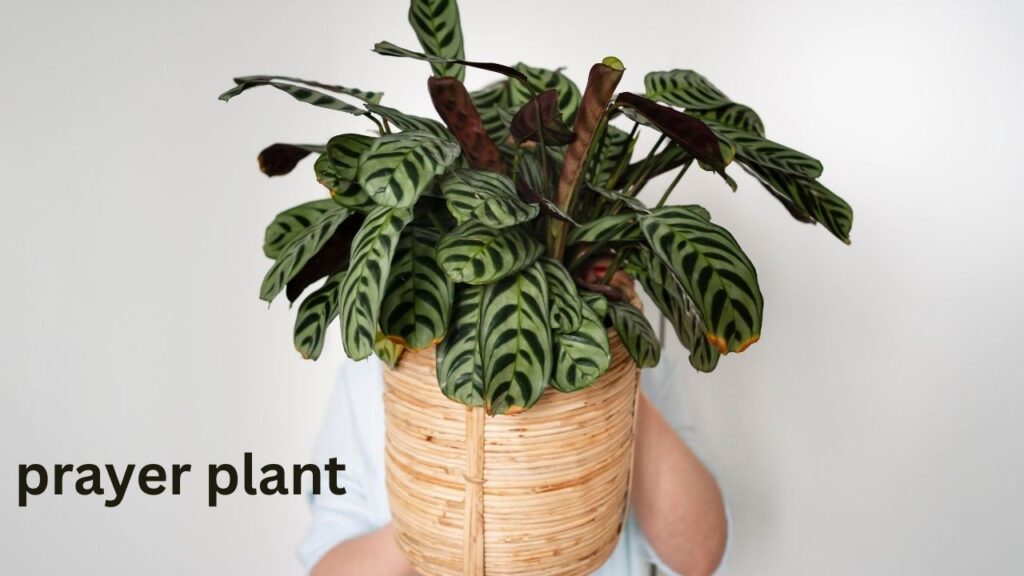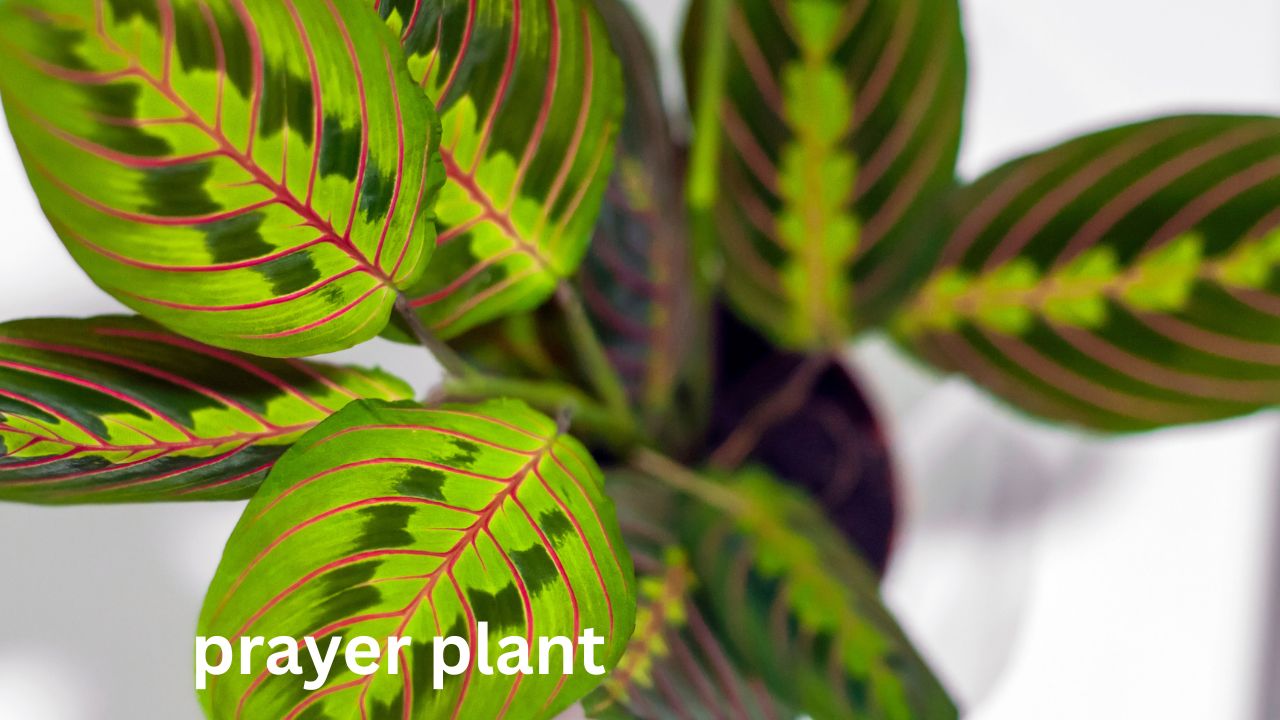If you’ve ever wanted a houseplant that feels a little magical, the prayer plant might just steal your heart. Known for its vibrant colors, striking leaf patterns, and quirky habit of folding its leaves like praying hands plant at night, this beauty is unlike any other. It’s not just another green friend sitting quietly in the corner of your home—it’s a living, moving piece of art that reacts to the world around it.
The scientific name for the prayer plant maranta leuconeura might sound a little fancy, but don’t let that scare you. Most people simply call it the maranta prayer plant, and it comes in stunning varieties like the red prayer plant with ruby veins, or the cheerful lemon lime prayer plant that glows with zesty green tones. Some people even confuse it with the calathea prayer plant, a close cousin, but true marantas have their own charm that makes them special.
So, why do people fall in love with prayer plants? Well, for starters, they’re gorgeous. The broad leaves are painted with intricate lines and patches of color, almost like nature’s own stained-glass window. But what really sets them apart is how they behave. By day, the leaves stretch outward to soak up the sun, and by night, they fold up tightly, almost like they’re whispering a bedtime prayer. This unique movement is why people sometimes call it the praying plant or even the plant prayer.
And here’s the fun part—when it comes to houseplants, the prayer plant is one of the friendlier ones to grow. With the right prayer plant care, you’ll be rewarded with lush growth, and if you’re really lucky, a delicate prayer plant flower might even bloom. Tiny, but full of charm, these blooms remind plant lovers that patience is always rewarded.
Why the Prayer Plant is So Popular
If you’ve ever walked into a plant store or searched for “prayer plant near me,” you’ll know they’re often in high demand. Their popularity isn’t just about looks; it’s about personality. Unlike plants that just sit still, the prayer plant feels alive. Watching the leaves lift and fold every day creates a connection—you’re reminded that plants aren’t just decorations, they’re living beings.
For people who want a houseplant that feels engaging but not overwhelming, the prayer plant is a top pick. Plus, it’s relatively easy to care for once you learn the basics. Whether you’re curious about how to care for a prayer plant, or you’re interested in prayer plant propagation to share with friends, this plant is both forgiving and rewarding.
What Makes the Prayer Plant Unique
- Nighttime Rituals – The prayer plant at night is like a small miracle. When the sun sets, the leaves slowly fold up, creating a striking “praying hands” look. By morning, they open again, ready for the day.
- Stunning Variety – From the bold maranta red prayer plant to the refreshing lemon lime prayer plant, each type has its own personality. The red variety is dramatic and striking, while the lemon-lime is bright and cheerful.
- Safe for Pets – One of the most asked questions is: “Are prayer plants toxic to cats?” Good news—they’re not! The prayer plant toxic to cats rumor isn’t true. Unlike many houseplants, prayer plants are safe for curious cats and dogs. That means no more worrying if your furry friend takes a nibble.
- Emotional Connection – There’s something soothing about a plant that “moves.” Many plant lovers find comfort in their praying plant, as if it’s meditating right alongside them.
Prayer Plant Care: The Basics
Now, let’s be real. No plant thrives on love alone. If you want a healthy, thriving prayer plant, a few basics are non-negotiable. Think of them like golden rules:
- Soil Matters – A prayer plant best soil mix ratio includes well-draining soil that holds some moisture but doesn’t stay soggy. A mix of potting soil, peat moss, and perlite usually does the trick.
- Watering – Keep the soil slightly moist, but don’t drown it. Prayer plants hate “wet feet,” which means roots sitting in too much water.
- Light – They love bright, indirect light. Direct sun can scorch those beautiful leaves, while too little light may cause drooping.
- Temperature & Humidity – Warm and humid is the way to go. Think tropical rainforest vibes, not dry desert air.
If you’ve noticed prayer plant leaves curling, that’s usually a cry for help. It could mean it’s too dry, too hot, or getting too much sun. Pay attention to these signals—your plant is literally “talking” to you!
Propagating the Prayer Plant
One of the best parts about owning a prayer plant is that you can share it. Curious about how to propagate prayer plant? It’s easier than you think.
There are two main methods:
- Division – When your prayer plant grows big enough, you can gently divide it into smaller sections and repot them.
- Stem Cuttings – Another method is praying plant propagation through cuttings placed in water or soil. With patience, roots will appear, and soon, you’ll have a brand-new plant.
Propagation isn’t just about growing more plants—it’s about spreading joy. Imagine gifting a loved one a healthy prayer plant plant that you propagated yourself. That’s a piece of living love right there.
The Mystery of Prayer Plant Blooms
Every now and then, with good care, you might witness a prayer plant bloom. While the flowers aren’t as flashy as orchids or roses, they’re delicate and charming. Tiny purple or white blossoms peek out, almost as if the plant is rewarding you for your dedication. It’s not something that happens every day, so when it does, it feels like a special gift.

A Prayer Plant’s Emotional Connection
Plants don’t just decorate our homes—they influence how we feel. The praying hands plant especially brings a sense of calm. Watching your prayer plant at night, folding its leaves as though it’s resting after a long day, can be strangely comforting. It’s almost like sharing a little bedtime ritual with nature.
Many people also feel connected to the idea of plant prayer, seeing the folding leaves as a symbol of gratitude or mindfulness. Whether or not you’re spiritual, there’s something deeply soothing about this plant’s daily rhythm.
Why the Prayer Plant Belongs in Your Home
Still wondering if the prayer plant is right for you? Let’s wrap it up with the big reasons:
- It’s beautiful, with patterns and colors that look hand-painted.
- It’s interactive, folding and opening its leaves daily.
- It’s safe, since it’s not toxic to pets.
- It’s rewarding, because with simple care, it thrives and may even flower.
- It’s shareable, thanks to easy prayer plant propagation.
At the end of the day, the maranta prayer plant isn’t just a plant—it’s a companion. It brings movement, beauty, and a touch of magic into your home. Whether you go for a red prayer plant, a lemon lime prayer plant, or a classic green variety, one thing is certain: this is a plant that gives back more than you expect.
Prayer Plant Care in Detail
If you’ve just brought home a prayer plant, or you’re thinking about getting one, the next big step is learning prayer plant care. Don’t worry—it’s not as tricky as it may seem. With the right tips, your prayer plants will thrive, show off their stunning leaves, and even surprise you with a prayer plant flower someday.
Think of it like this: taking care of a praying plant is a bit like looking after a pet. It needs attention, the right “food,” and a comfortable space. In return, it rewards you with beauty and joy. Let’s dive into everything you need to know about how to care for a prayer plant—from soil and watering to light, temperature, and beyond.
1. Understanding the Prayer Plant’s Nature
The maranta prayer plant (scientific name: Maranta leuconeura) gets its nickname because of how its leaves fold together at night, like praying hands plant. This isn’t just for show—it’s part of its survival strategy in the wild, where folding leaves protect it from too much moisture loss.
But here’s the good news: you don’t need to live in a rainforest to care for one. With the right setup at home, even in a small apartment, your prayer plants can feel right at home.
2. Light Requirements
Light is one of the most important parts of prayer plant care.
- What it loves: Bright, indirect light. Think of a spot near a sunny window with sheer curtains. Too much direct sunlight can scorch the leaves.
- What it tolerates: Low light. Yes, your praying plant can survive in lower light, but it won’t grow as quickly, and the colors might not look as vibrant.
Tip: If you notice your prayer plant leaves curling, it might be getting too much direct sun—or not enough water. Move it to a gentler light spot, and it should perk up.
3. Watering the Prayer Plant
This is where many plant parents get nervous. But don’t worry—watering a maranta red prayer plant or a lemon lime prayer plant isn’t rocket science.
- How often? About once a week, depending on your climate and season.
- The rule of thumb: Keep the soil slightly moist, but never soggy. Soggy soil can lead to root rot.
- Check before you pour: Stick your finger in the soil about an inch deep. If it feels dry, it’s time to water.
Extra Tip: Always use room-temperature water. Cold water can shock the roots.
4. The Best Soil Mix for Prayer Plants
Your prayer plant best soil mix ratio is key to healthy growth. The soil should be:
- Well-draining (so roots don’t rot)
- Moisture-retentive (so roots don’t dry out)
- Nutrient-rich (to support those gorgeous leaves)
A great prayer plant soil mix is:
- 2 parts peat moss or coco coir
- 1 part perlite
- 1 part potting soil
This blend keeps things airy while holding just the right amount of water.
5. Temperature and Humidity
Since prayer plants originally come from tropical regions, they love warmth and humidity.
- Ideal temperature: 65–75°F (18–24°C).
- Humidity level: High (over 50%).
How to increase humidity:
- Place your plant on a pebble tray with water.
- Mist the leaves occasionally.
- Group plants together.
- Use a humidifier if your home is very dry.
If your prayer plant leaves curling or edges turn brown, it may be begging for more humidity.
6. Fertilizing Your Prayer Plant
Your prayer plant maranta leuconeura doesn’t need much food, but it does enjoy a boost.
- When: Every 4 weeks in spring and summer.
- What to use: A balanced, water-soluble houseplant fertilizer (diluted to half strength).
Skip fertilizing in winter, when the plant rests. Too much food can actually harm it.
7. Pruning and Grooming
Keeping your prayer plant plant neat is easy. Just snip away dead or yellowing leaves with clean scissors. Pruning also encourages bushier growth.
And don’t forget to wipe the leaves with a damp cloth every once in a while. Dust can block sunlight and affect its ability to breathe.
8. Propagating Prayer Plants
One of the most fun parts of prayer plant care is making more plants! Yes, prayer plant propagation is simple. Here’s how to propagate prayer plant:
- Cut a stem just below a node (where a leaf grows).
- Place it in water or moist soil.
- In 2–4 weeks, roots should appear.
This process is also called praying plant propagation, and it’s a great way to share the love with friends and family.
9. Flowers on a Prayer Plant
You may not expect it, but sometimes a prayer plant bloom can happen. The flowers are small and white or purple—not as dramatic as the leaves, but still special. Think of it as a bonus gift from your plant.
10. Common Issues and Fixes
Even with the best care, your calathea prayer plant or maranta red prayer plant may show signs of stress. Here’s what to look out for:
- Prayer plant leaves curling: Usually too much sun, not enough water, or low humidity.
- Yellow leaves: Overwatering or poor drainage.
- No growth: Not enough light or nutrients.
Good news: Most of these problems are fixable once you figure out the cause.
11. Safety: Are Prayer Plants Toxic?
Pet parents often ask: are prayer plants toxic to cats? The answer is no—they are non-toxic to cats and dogs. That means you can enjoy your plant prayer hobby without worrying about your furry friends.
Still, curious cats may nibble the leaves, so it’s smart to keep your prayer plant toxic to cats concern in mind and place the plant somewhere safe.
12. Where to Buy a Prayer Plant
If you’re wondering, “Where can I find a prayer plant near me?” the answer is simple:
- Local nurseries
- Garden centers
- Online plant shops
Look for healthy leaves, no brown spots, and moist—not soggy—soil before buying.
13. What Happens at Night?
One of the coolest things about a prayer plant at night is how its leaves fold up, like praying hands plant. This nightly routine is called nyctinasty. It’s what makes the praying plant so unique and lovable.
14. Prayer Plant Varieties You’ll Love
There isn’t just one type of prayer plant—there are many! Some favorites include:
- Maranta red prayer plant – with red veins running through the leaves.
- Lemon lime prayer plant – featuring bright green and yellow patterns.
- Calathea prayer plant – a close cousin with equally stunning foliage.
Each variety has its charm, but they all follow the same prayer plant care rules.
Final Thoughts
Caring for a prayer plant is a joy. It’s forgiving, stunning, and interactive—it “moves” with the day. By understanding how to care for a prayer plant—from light and water to soil and humidity—you can create the perfect environment for it to flourish.
Remember, whether it’s a red prayer plant, a lemon lime prayer plant, or a calathea prayer plant, they all thrive with a little love and attention. Keep an eye out for prayer plant bloom, enjoy the magic of prayer plant at night, and don’t forget—you can always expand your collection with a little prayer plant propagation.
With these steps, you’ll go from beginner to expert in prayer plant care, and your green companion will reward you with beauty for years to come.
Types of Prayer Plants
If you thought there was just one kind of prayer plant, you’re in for a surprise. There are actually several different varieties, each with its own unique colors, patterns, and personalities. These plants all belong to the Maranta family and are often admired for their bright leaves that fold up like praying hands plant at night. Let’s explore the most popular and exciting types of prayer plants you might come across.
1. Maranta Leuconeura (The Classic Prayer Plant)
The prayer plant maranta leuconeura is the most famous of them all. It has green leaves with stunning red veins that look like they were painted by hand. This type is often called the maranta red prayer plant because of its vibrant stripes. It’s the one most people picture when they hear the words maranta prayer plant.
Fun fact: This variety is especially easy to find if you search “prayer plant near me” at local nurseries or online plant shops.
2. Red Prayer Plant
The red prayer plant is sometimes used to describe the maranta red prayer plant, but some growers also use it for other bold red-veined types. Its bright leaf veins make it stand out in any room. When it folds up at night, the red lines become even more eye-catching.
If you’re new to indoor gardening, this is a perfect pick because it’s hardy, beautiful, and fairly simple when it comes to prayer plant care.
3. Lemon Lime Prayer Plant
The lemon lime prayer plant is a cheerful variety with fresh green leaves and light yellow to lime-colored veins. Compared to the red prayer plant, this one feels a little softer and brighter, almost like a splash of sunshine in your home.
Plant lovers adore it because it pairs beautifully with other houseplants and adds variety to your collection.
4. Calathea Prayer Plant
Some people call Calathea prayer plant types “prayer plants,” even though they’re not exactly the same as Maranta. Why? Because calathea prayer plant leaves also move with light, showing off gorgeous purple undersides when they fold up at night.
If you want a dramatic, tropical feel in your home, calatheas are perfect. Just remember that calathea prayer plants can be a little fussier than marantas, so they need extra care.
5. Rare Blooms – Prayer Plant Flower
While we often admire them for their leaves, did you know that a prayer plant flower can appear too? It’s small, delicate, and usually white or light purple. Not every prayer plant bloom happens indoors, but when it does, it feels magical—like your plant is giving you a little gift for all your care.
6. The Praying Plant Mix
Beyond these main types, growers sometimes offer hybrids or special variations of prayer plants that mix colors and patterns. Whether you choose a maranta red prayer plant, a lemon lime prayer plant, or a calathea prayer plant, all of them share the same charm: beautiful moving leaves that fold at night like a praying plant.
Quick Tip: No matter which type you choose, remember the basics—good soil, water balance, and light—because the needs for how to care for a prayer plant are mostly the same across varieties.
To sum it up: From the bold red veins of the red prayer plant to the cheerful tones of the lemon lime prayer plant, and even the delicate surprise of a prayer plant flower, each variety has something unique to offer. Collecting different types is like creating a living gallery of nature’s artwork right in your home.




